Reception: ![]() +36/30 show
+36/30 show
6721 Szeged, Osztrovszky utca 12.
Open every week-day since 1996
Open on week-days from 8 AM to 9 PM
24 578 satisfied customers
Serving you since 1996
Beautiful, healthy, and well-aligned teeth help radiate harmony. More and more of our patients come to us with this thought in mind. Others are looking for dental restorations that do not merely give them back their original chewing ability but that also give them an attractive smile. When professional, functional, and aesthetic considerations are given equal importance during the design, production, and fitting of dental prosthetics, we talk about cosmetic dentistry.
During smile planning, you and your dentist work together to decide what your beautiful new smile will look like. This takes place before any treatment is done.
Smile planning helps more accurately define your and your dentist’s ideas as it involves images rather than just words.
Before smile planning technology existed, any of the following scenarios could easily lead to misunderstandings:
In view of the above, the following issues are discussed during dental consultation:
We recommend smile planning when you have any of the following dental problems:
vissza a kérdésekhez

From your decision to go ahead, your cosmetic dental restorations may take less than a week to manufacture! (The time actually needed is, of course, subject to the complexity of the intervention.)
vissza a kérdésekhez

Filling a tooth may seem a simple and fast procedure. It is the most commonly performed inter-vention at our dentistry. However, today’s high aesthetic expectations mean that even a simple filling should look just perfect. Are you thinking about fillings that meet the highest standards in terms of their aesthetic appearance? Thanks to scientific progress in dentistry, today we can offer sophisticated solutions to our patients that were unheard of even just a few years ago.
There are three criteria that aesthetic fillings must meet:
As a result of our lifestyle and nutritional habits, dental caries (tooth decay) is a common phe-nomenon. The earlier it is treated the easier it is to prevent bacteria from proliferating and causing inflammations. Thanks to aesthetic fillings, the chewing ability of the tooth will be the same as it was in its original healthy state; at the same time, they match the original colour of your tooth so your filling will be invisible.
Often, there may be more than one solution to a dental problem. Call our dentistry at +36 30 206 9532 for a consultation to find out about the possible alternatives and to chose the one that is best for you.
vissza a kérdésekhez
Light-curing fillings matching the colour of your tooth are made of a special composite material, a resin reinforced with glass or ceramic beads. Once he has removed any dental decay, the dentist uses this soft filling material to restore your tooth to a lifelike shape. Thanks to this material, the surface of the decayed and restored tooth, as well as its chewing ability, will be exactly like those of a healthy tooth. This composite material is as hard as natural dental enamel, which makes it a durable and aesthetically appealing solution.
These photos demonstrate the spectacular change in the appearance of a tooth when the amalgam is replaced with an aesthetic composite filling.
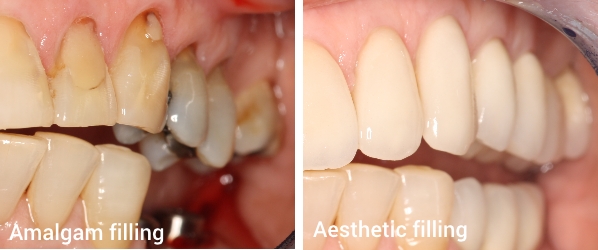
Affected by dental caries, the teeth on the left have been treated and received light-curing aesthetic fillings:
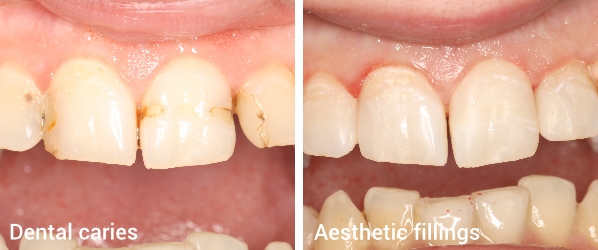
Would you like to get a few fillings, or have some of your existing amalgam fillings replaced with a composite that matches the colour of your teeth? Call our dentistry at +36 30 206 9532 for an appointment.
vissza a kérdésekhezSome dental problems may not be possible to solve using a filling or an inlay. In such cases, we will propose a crown or a bridge as the solution to restore your tooth or teeth. Our zirconium ceramic crowns and bridges offer a host of advantages over the traditional metal ceramic solu-tion because they are metal free, they do not provoke allergic reactions, they have great aes-thetic appeal, and they can be fitted with extreme precision in the range of a thousandth of a millimetre. No wonder they are becoming ever more popular with our patients.
Restorations that fit naturally
Zirconium crowns and bridges blend in with your existing teeth – no one will be able to tell that you even have them fitted. The dark tone of the crown or bridge and the grey line around the edge of the gums, typical of metal ceramics, are now things of the past. Zirconium crowns and bridges match the natural colour of your existing teeth.
Of high aesthetic appeal, metal free zirconium ceramic crowns and bridges are prepared simi-larly to traditional metal ceramic dental restorations. Your dentist will remove any damage or decay, then take an impression of your affected teeth using dental putty and send it off to the dental laboratory. Instead of casting it in metal, the dental laboratory will mill the interior of your future dental prosthesis in zirconium, using CAD/CAM technology.
This technology allows us to achieve the greatest possible precision. As the first step, the dental lab will use a special laser scanner to obtain a 3D image of the impression taken of your tooth. Then, with the help of a computer, a restoration is custom-designed and manufactured for you. Your dentist will check how well the interior of the restoration fits your tooth. If the fit is per-fect, the dental lab proceeds to fuse the porcelain to the zirconium interior. This grants your restoration great aesthetic appeal. If the zirconium crown or bridge is to your satisfaction both in terms of appearance and comfort, your dentist will cement it in position permanently. The result is a perfect fit, great durability, and great natural appearance.
vissza a kérdésekhez
Even today, metal ceramic crowns and bridges continue to be the most popular type of dental restoration. With all pros and cons considered, traditional metal ceramic crowns and bridges have for decades offered a lasting solution to certain dental problems:
Metal ceramic restorations – The pros and the cons
Metal ceramic restorations – The pros:
Metal ceramic restorations – The cons:
Metal ceramic crowns are made in a similar way to metal free restorations, the difference being in how the dental laboratory produces them:
Learn more about metal ceramic crowns and bridges! Call +36 30 206 9532 for a consultation appointment with our experienced dental specialists.
vissza a kérdésekhez
Ceramic veneers offer outstanding advantages both in terms of aesthetic appeal and functionality. A lot less of the tooth matter is drilled away than in the case of a having a crown fitted. The aesthetic result they deliver is lasting, and they are resistant to wear.
What is a pressed ceramic veneer?
A pressed ceramic veneer is a layer of porcelain as thin as a contact lens that is fitted over the front of the tooth. Veneers give a renewed, beautiful appearance to your incisors. Because of their unparalleled properties, veneers are extremely popular with celebrities all over the world. We recommend that you consider dental veneers for making your smile more beautiful if:
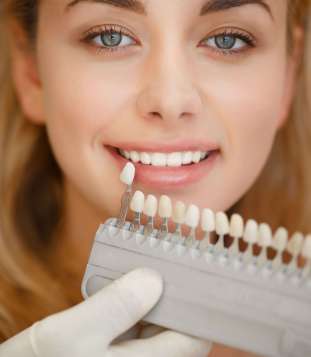
The essence of biomimetics is to copy nature. During biomimetic filling we are using materials of different elasticity, in different layer thickness, including fiberglass. The effects of all these elements added together strengthen the tooth.
Just like nature created tooth from different parties, dental filling is also made up of different parties. We restore tooth loss caused by dental decay in accordance with the dental tissues, this way we protect teeth longevity. We can create a strengthened filling by using biomimetic technology in case of minor and medium-sized decay of a healthy (and not root canal) tooth. The crown-level of a tooth is composed of two types of hard tissue; the outer layer is the dental enamel (0,5 -2,5 mm thickness), the inner layer is the dentin. Dental enamel is a glass-like material that is very hard, but also very fragile. Dentin is also a hard tissue, but significantly softer, with more elasticity than dental enamel. By stratifying the different layers on each other, we can alloy their favourable features. One can imagine that like a tennis rocket. If we knock down the tennis rocket, in which there is no string, its frame will easily be broken. But if there are strings within its frame, and we knock it down so, the rocket will jump up real high. By using biomimetic filling, like in the example of the stringed tennis rocket, we strengthen the teeth, so they will better support the continuous dental load or in case of an eventual sudden force impact (for example: bite on cherry seed) the result will be a so-called favourable fracture, that ensures the survival of the tooth.
To rebuild a root canal tooth or repair serious dental caries, an inlay/onlay restoration is suggested. When the caries touch the level of dental veins and nerves, the loss of dental material is so significant that a biomimetically strengthened filling in itself is not enough anymore to restore the tissues of the tooth. Such a solution is needed, that includes and embraces the corners so that it doesn’t let the tooth to crack. Instead of the crown, the inlay/onlay restoration goes along with the sacrifice of much less healthy dental material, its edge doesn’t reach down to the level of the soft palate, so its much easier to control and to clean. During its sticking (cementation), the edge of the inlay/onlay layer can be completely adjusted to the dental material by grinding. Doing so, the possibility of decaying is significantly decreased. It can also be repaired in case of smaller decay, or if it needs to be changed than most often a larger onlay is enough. In fact, the inlay/onlay is an intermediate step between filling and crown, by using it, the longevity of the tooth can be significantly increased. Most of the times, the inlay/onlay is made of material without metal, generally of lithium-disilicate ceramic, but it can also be made of zirconium, hybrid-ceramic or metal (even gold).
Written by: Dr. Kristóf Benedek
vissza a kérdésekhezIn former times, amalgam fillings were fixed to the tooth by the visible, so-called undergoing zones (macro retention elements) In case of such a fixing method, the filling is kept in the right position by merely physical fixing factors. That’s why it’s typical, that if a tooth with amalgam filling is damaged by dental decay or simply breaks out, then at the same time the filling falls out, too. This macro retention relation means a much weaker resistance for the bacteries, than a chemical or a microretentional relation.
When using adhesive techniques usually we wear a cofferdam isolation, to ensure the completely dry surroundings, so saliva, tongue, and the higher damp content of the in/exhaled air can not disturb the formation of the right chemical bond. In this case, the surface of the tooth should be treated by special materials (during sticking crown/inlay than their respective surfaces as well), so that we are able to create the right bond. In this way, along with the physical joint, indirectly we can reach a chemical bond as well. We can also significantly enlarge the surface of the sticking zone by creating micro-irregularities during the treatment of the dental material, so the sticking will turn to be much more stable.
To achieve this in a high quality, we should apply complex but efficient protocols. In our dental clinic, we use the same method when filling, sticking inlay/onlay restoration, or ceramic and zirconia crowns, so by this we can guarantee a long-lasting and successful treatment for our clients.
Written by: Dr. Kristóf Benedek
vissza a kérdésekhezOccasionally, tooth decay may be so extensive that composite fillings are not any more an op-tion. In such cases, the solution may be one of two types of indirect restoration: inlays and onlays.
Inlays and onlays are a special type of filling that are normally made in a dental laboratory in about a week’s time. However, Dentha Dentistry has the special machinery that helps solve this problem in as little time as an hour. You may read more about this later in this section.
Additional advantages of inlays and onlays:
The procedure
In the case of inlays and onlays, the dentist removes all dental decay from the tooth, then takes an impression using dental putty and sends it out to the dental laboratory. The technicians at the lab produce your inlay or onlay on the basis of the impression. Your dentist prepares your tooth and tries in the restoration, and if it is perfect in every sense, cements it in position per-manently.
vissza a kérdésekhez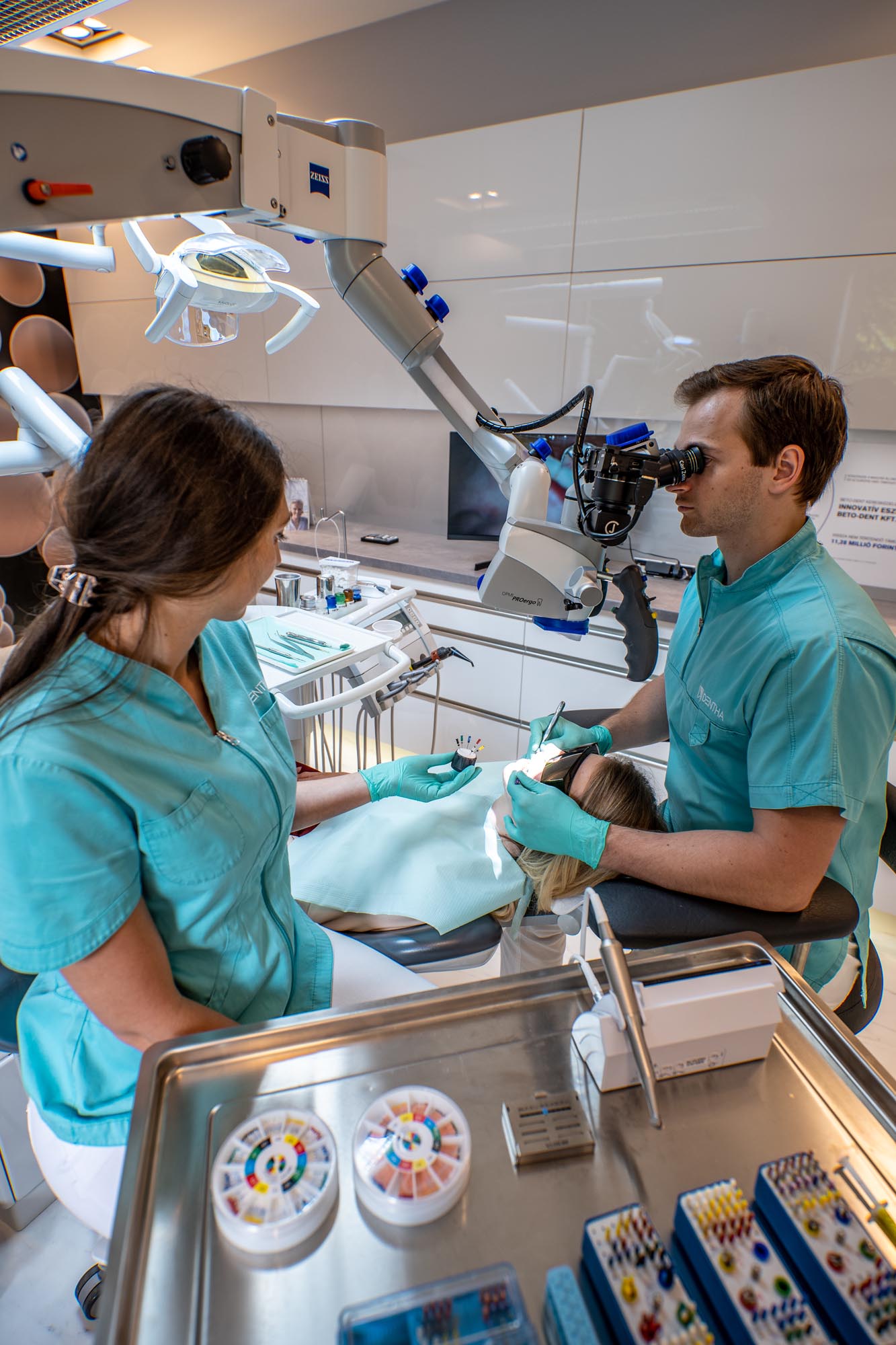
Tartar or calculus is the calcified, hardened version of the dental plaque that generates in your mouth. It causes a lot of problems, so it is a good idea to get it periodically removed since it always builds up again. If you do not remove the plaque from your saliva by brushing your teeth correctly and by using dental floss, calcium crystal deposits form on your teeth creating tartar.
Tartar is not always visible. If it builds up above your gum line, its yellowish-white colour will make it apparent. However, if it is accumulating under your gum, you often do not even notice it. If you ignore tartar because it is invisible, it may lead to gingivitis or periodontitis.
Your teeth may become stained as a result of smoking or consuming certain types of food. Building up on your teeth, this apparent brownish layer cannot be removed by home remedies.
Accordingly, it is very important to make sure that you have your teeth checked regularly, once every six months, and if your dentist recommends it or considers it necessary, have your tartar or stains removed by our qualified assistants specialised in dental hygiene. Such health aware behaviour can save you a lot of discomfort and pain.
Dental hygiene treatment is a 30 to 40 minute pain-free intervention offered at our dentistry that consists of the following stages:
Visit our dentistry and ask for dental hygiene treatment to prevent unpleasant periodontitis and to give back your teeth their vibrant glow! Call +36 30 206 9532 for a dental hygiene treatment appointment.
vissza a kérdésekhez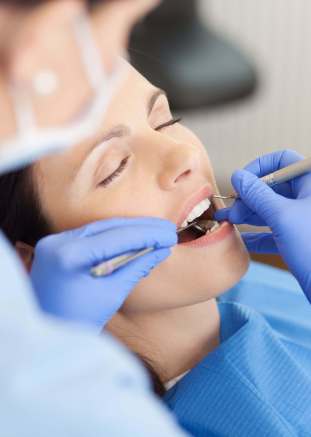
Teeth whitening makes your smile more beautiful and helps strengthen your confidence. Today, provided that you have the right professional to do it for you, teeth whitening is a simple and efficient intervention available to everyone.
What should you watch out for if you would like to have your teeth whitened?
Our dentistry offers you teeth whitening with the highest level of safety. We accept no com-promises in terms of the quality of the teeth whitening materials we use. We rely on a modern technology and our staff have decades of hands-on experience in teeth whitening.
Come visit our dentistry and try teeth whitening! Call +36 30 206 9532 for a teeth whitening ap-pointment!
vissza a kérdésekhez